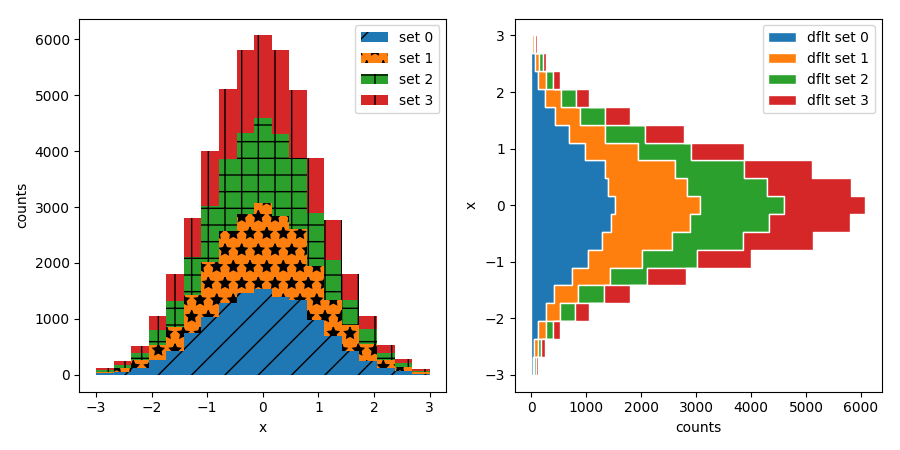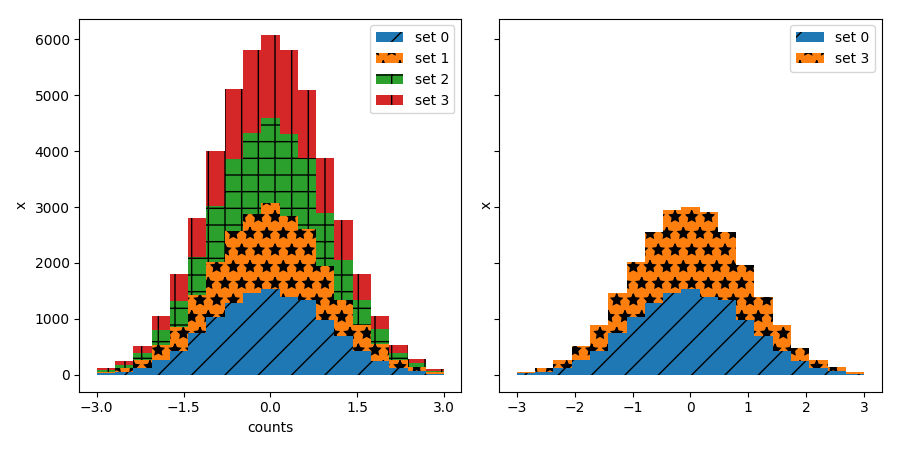Version 2.0.0b1.post7580.dev0+ge487118

Hatching capabilities for plotting histograms.
import itertools
from collections import OrderedDict
from functools import partial
import numpy as np
import matplotlib.pyplot as plt
import matplotlib.ticker as mticker
from cycler import cycler
from six.moves import zip
def filled_hist(ax, edges, values, bottoms=None, orientation='v',
**kwargs):
"""
Draw a histogram as a stepped patch.
Extra kwargs are passed through to `fill_between`
Parameters
----------
ax : Axes
The axes to plot to
edges : array
A length n+1 array giving the left edges of each bin and the
right edge of the last bin.
values : array
A length n array of bin counts or values
bottoms : scalar or array, optional
A length n array of the bottom of the bars. If None, zero is used.
orientation : {'v', 'h'}
Orientation of the histogram. 'v' (default) has
the bars increasing in the positive y-direction.
Returns
-------
ret : PolyCollection
Artist added to the Axes
"""
print(orientation)
if orientation not in set('hv'):
raise ValueError("orientation must be in {{'h', 'v'}} "
"not {o}".format(o=orientation))
kwargs.setdefault('step', 'post')
edges = np.asarray(edges)
values = np.asarray(values)
if len(edges) - 1 != len(values):
raise ValueError('Must provide one more bin edge than value not: '
'len(edges): {lb} len(values): {lv}'.format(
lb=len(edges), lv=len(values)))
if bottoms is None:
bottoms = np.zeros_like(values)
if np.isscalar(bottoms):
bottoms = np.ones_like(values) * bottoms
values = np.r_[values, values[-1]]
bottoms = np.r_[bottoms, bottoms[-1]]
if orientation == 'h':
return ax.fill_betweenx(edges, values, bottoms,
**kwargs)
elif orientation == 'v':
return ax.fill_between(edges, values, bottoms,
**kwargs)
else:
raise AssertionError("you should never be here")
def stack_hist(ax, stacked_data, sty_cycle, bottoms=None,
hist_func=None, labels=None,
plot_func=None, plot_kwargs=None):
"""
ax : axes.Axes
The axes to add artists too
stacked_data : array or Mapping
A (N, M) shaped array. The first dimension will be iterated over to
compute histograms row-wise
sty_cycle : Cycler or operable of dict
Style to apply to each set
bottoms : array, optional
The initial positions of the bottoms, defaults to 0
hist_func : callable, optional
Must have signature `bin_vals, bin_edges = f(data)`.
`bin_edges` expected to be one longer than `bin_vals`
labels : list of str, optional
The label for each set.
If not given and stacked data is an array defaults to 'default set {n}'
If stacked_data is a mapping, and labels is None, default to the keys
(which may come out in a random order).
If stacked_data is a mapping and labels is given then only
the columns listed by be plotted.
plot_func : callable, optional
Function to call to draw the histogram must have signature:
ret = plot_func(ax, edges, top, bottoms=bottoms,
label=label, **kwargs)
plot_kwargs : dict, optional
Any extra kwargs to pass through to the plotting function. This
will be the same for all calls to the plotting function and will
over-ride the values in cycle.
Returns
-------
arts : dict
Dictionary of artists keyed on their labels
"""
# deal with default binning function
if hist_func is None:
hist_func = np.histogram
# deal with default plotting function
if plot_func is None:
plot_func = filled_hist
# deal with default
if plot_kwargs is None:
plot_kwargs = {}
print(plot_kwargs)
try:
l_keys = stacked_data.keys()
label_data = True
if labels is None:
labels = l_keys
except AttributeError:
label_data = False
if labels is None:
labels = itertools.repeat(None)
if label_data:
loop_iter = enumerate((stacked_data[lab], lab, s) for lab, s in
zip(labels, sty_cycle))
else:
loop_iter = enumerate(zip(stacked_data, labels, sty_cycle))
arts = {}
for j, (data, label, sty) in loop_iter:
if label is None:
label = 'dflt set {n}'.format(n=j)
label = sty.pop('label', label)
vals, edges = hist_func(data)
if bottoms is None:
bottoms = np.zeros_like(vals)
top = bottoms + vals
print(sty)
sty.update(plot_kwargs)
print(sty)
ret = plot_func(ax, edges, top, bottoms=bottoms,
label=label, **sty)
bottoms = top
arts[label] = ret
ax.legend(fontsize=10)
return arts
# set up histogram function to fixed bins
edges = np.linspace(-3, 3, 20, endpoint=True)
hist_func = partial(np.histogram, bins=edges)
# set up style cycles
color_cycle = cycler(facecolor=plt.rcParams['axes.prop_cycle'][:4])
label_cycle = cycler('label', ['set {n}'.format(n=n) for n in range(4)])
hatch_cycle = cycler('hatch', ['/', '*', '+', '|'])
# Fixing random state for reproducibility
np.random.seed(19680801)
stack_data = np.random.randn(4, 12250)
dict_data = OrderedDict(zip((c['label'] for c in label_cycle), stack_data))
Work with plain arrays
fig, (ax1, ax2) = plt.subplots(1, 2, figsize=(9, 4.5), tight_layout=True)
arts = stack_hist(ax1, stack_data, color_cycle + label_cycle + hatch_cycle,
hist_func=hist_func)
arts = stack_hist(ax2, stack_data, color_cycle,
hist_func=hist_func,
plot_kwargs=dict(edgecolor='w', orientation='h'))
ax1.set_ylabel('counts')
ax1.set_xlabel('x')
ax2.set_xlabel('counts')
ax2.set_ylabel('x')

Out:
{}
{'facecolor': '#1f77b4', 'hatch': '/'}
{'facecolor': '#1f77b4', 'hatch': '/'}
v
{'facecolor': '#ff7f0e', 'hatch': '*'}
{'facecolor': '#ff7f0e', 'hatch': '*'}
v
{'facecolor': '#2ca02c', 'hatch': '+'}
{'facecolor': '#2ca02c', 'hatch': '+'}
v
{'facecolor': '#d62728', 'hatch': '|'}
{'facecolor': '#d62728', 'hatch': '|'}
v
{'edgecolor': 'w', 'orientation': 'h'}
{'facecolor': '#1f77b4'}
{'facecolor': '#1f77b4', 'edgecolor': 'w', 'orientation': 'h'}
h
{'facecolor': '#ff7f0e'}
{'facecolor': '#ff7f0e', 'edgecolor': 'w', 'orientation': 'h'}
h
{'facecolor': '#2ca02c'}
{'facecolor': '#2ca02c', 'edgecolor': 'w', 'orientation': 'h'}
h
{'facecolor': '#d62728'}
{'facecolor': '#d62728', 'edgecolor': 'w', 'orientation': 'h'}
h
Work with labeled data
fig, (ax1, ax2) = plt.subplots(1, 2, figsize=(9, 4.5),
tight_layout=True, sharey=True)
arts = stack_hist(ax1, dict_data, color_cycle + hatch_cycle,
hist_func=hist_func)
arts = stack_hist(ax2, dict_data, color_cycle + hatch_cycle,
hist_func=hist_func, labels=['set 0', 'set 3'])
ax1.xaxis.set_major_locator(mticker.MaxNLocator(5))
ax1.set_xlabel('counts')
ax1.set_ylabel('x')
ax2.set_ylabel('x')
plt.show()

Out:
{}
{'facecolor': '#1f77b4', 'hatch': '/'}
{'facecolor': '#1f77b4', 'hatch': '/'}
v
{'facecolor': '#ff7f0e', 'hatch': '*'}
{'facecolor': '#ff7f0e', 'hatch': '*'}
v
{'facecolor': '#2ca02c', 'hatch': '+'}
{'facecolor': '#2ca02c', 'hatch': '+'}
v
{'facecolor': '#d62728', 'hatch': '|'}
{'facecolor': '#d62728', 'hatch': '|'}
v
{}
{'facecolor': '#1f77b4', 'hatch': '/'}
{'facecolor': '#1f77b4', 'hatch': '/'}
v
{'facecolor': '#ff7f0e', 'hatch': '*'}
{'facecolor': '#ff7f0e', 'hatch': '*'}
v